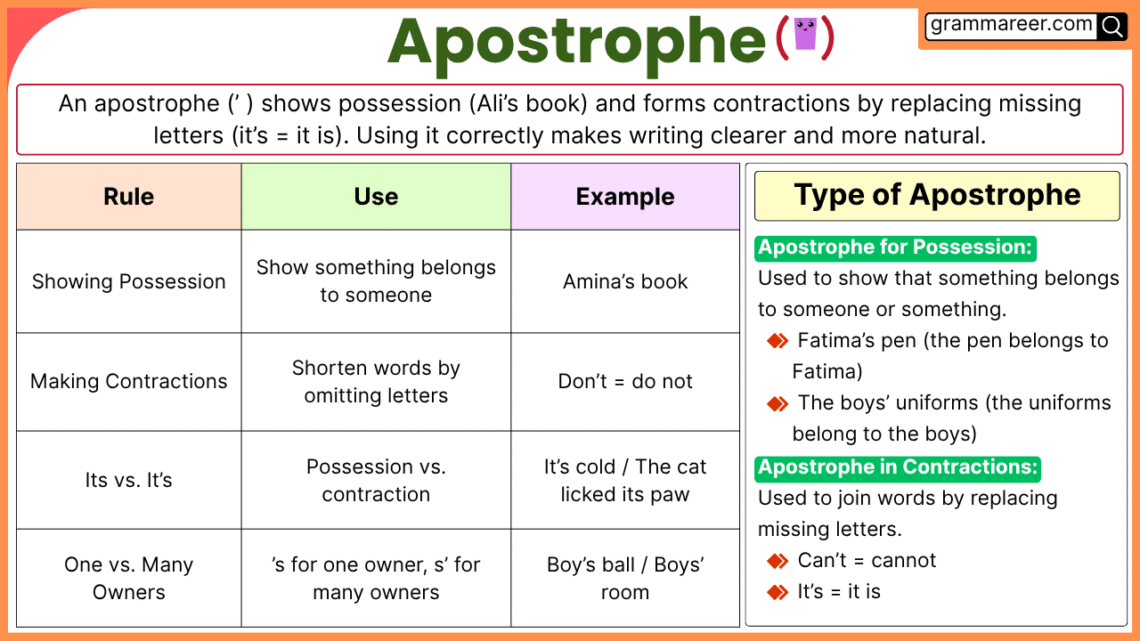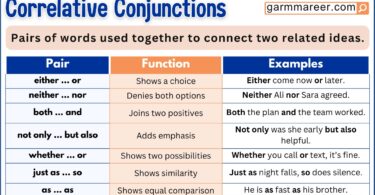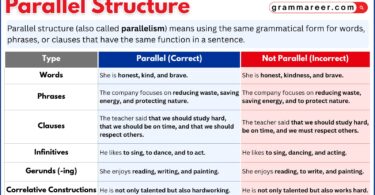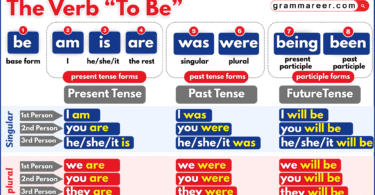An apostrophe is a punctuation mark (’) that shows something belongs to someone or that some letters are missing in a word. It helps make writing clear and easy to read. In English grammar, the apostrophe is small but very important. Many beginners find it confusing, especially when showing possession or using short forms like “can’t” or “it’s.” Learning how to use the apostrophe in English grammar will improve your writing and avoid common mistakes.
Table of Contents
What Is an Apostrophe?
An apostrophe ( ’ ) is a small punctuation mark used in English grammar to make writing clearer and more natural. It serves two main purposes. First, it shows possession, meaning something belongs to someone or something—for example, Ali’s book means the book belongs to Ali. Second, it is used in contractions, where two words are combined, and some letters are left out. The apostrophe replaces the missing letters. For example, It’s raining is a shorter form of It is raining. Understanding how to use apostrophes correctly helps you write better and speak more fluently in everyday English.
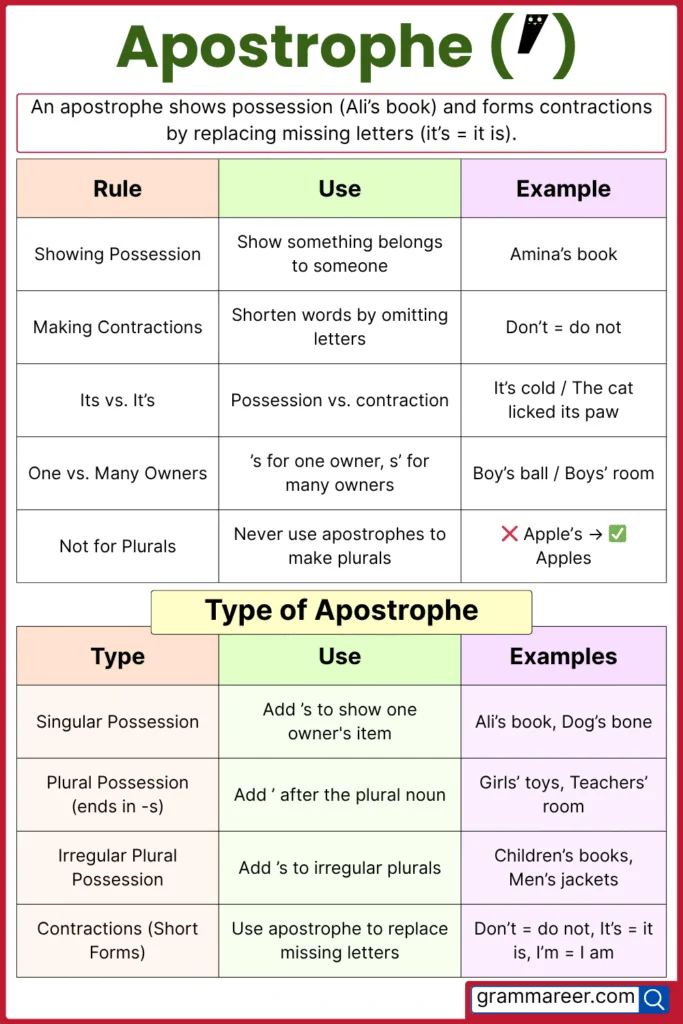
Why Do We Use Apostrophes in English?
We use apostrophes in English for two main reasons:
- To show that something belongs to someone (possession)
– Example: Sara’s book means the book belongs to Sara. - To make contractions by joining two words and leaving out letters
– Example: Don’t means do not (the apostrophe shows the missing “o”).
Apostrophes help make our writing clear and easier to understand.
Apostrophe Rules to Remember
🔹 1. Showing Possession (Something belongs to someone)
- 👉 Add ’s to a singular noun
Example: Ali’s bag → The bag belongs to Ali - 👉 Add only ’ to a plural noun that ends in -s
Example: Girls’ school → The school of the girls - 👉 Add ’s to irregular plurals (words that don’t end in -s)
Example: Children’s toys → Toys of the children
🔹 2. Making Contractions (Short Forms)
Use an apostrophe to replace missing letters when combining two words:
- I’m = I am
- Don’t = Do not
- It’s = It is / It has
- He’s = He is / He has
- They’re = They are
🔹 3. Never Use Apostrophes for Plurals
❌ Banana’s (This is wrong if you just mean more than one banana)
✅ Bananas (Correct – just add s, no apostrophe)
🔹 4. Its vs. It’s – Know the Difference!
- It’s = It is or It has
👉 It’s cold outside. (It is cold) - Its = shows belonging (no apostrophe)
👉 The cat licked its paw. (The paw of the cat)
🔹 5. One Owner vs. Many Owners
- ✅ One owner: My friend’s house → One friend
- ✅ More than one owner: My friends’ house → Many friends
Types of Apostrophes with Examples
Apostrophes are used in English to show possession (who owns something) and to make words shorter. Let’s look at each type in detail with easy examples!
1. Apostrophe for Possession (Ownership)
We use an apostrophe to show that something belongs to someone. This is called possessive apostrophe.
- Singular Possession (One person or thing):
- When one person or thing owns something, we add ’s to their name or noun.
- Ali’s book → The book belongs to Ali.
- The dog’s bone → The bone belongs to the dog.
- When one person or thing owns something, we add ’s to their name or noun.
- Plural Possession (More than one person or thing):
- When more than one person or thing owns something, we add ’ (just the apostrophe) after the plural noun.
- The girls’ toys → The toys belong to the girls.
- The teachers’ room → The room belongs to the teachers.
- When more than one person or thing owns something, we add ’ (just the apostrophe) after the plural noun.
- For Irregular Plurals (Words that don’t end in s):
- If the plural form of the noun doesn’t end in s, we still add ’s.
- The children’s books → The books belong to the children.
- The men’s jackets → The jackets belong to the men.
- If the plural form of the noun doesn’t end in s, we still add ’s.
2. Apostrophe in Contractions (Short Forms)
Apostrophes are also used to make two words shorter. This is called a contraction. When we join two words, we leave out some letters and use an apostrophe to show where the letters are missing.
- Don’t = Do not
– We leave out o from not and add an apostrophe. - It’s = It is
– We leave out i from is and add an apostrophe. - I’m = I am
– We leave out a from am and add an apostrophe.
Common Contractions:
- They’re = They are
- We’re = We are
- You’ve = You have
- She’s = She is
Common Apostrophe Mistakes and How to Avoid Them
Apostrophes can be confusing, but if you know the common mistakes, it will be easier to use them correctly. Let’s look at the most common mistakes and how to avoid them.
1. Don’t Use Apostrophes for Plurals (More Than One)
Apostrophes are not used to show more than one of something.
- Wrong: Apple’s (This means something belongs to the apple, not more apples.)
- Correct: Apples (This means more than one apple.)
Tip: To make a word plural (more than one), just add s or es without using an apostrophe.
2. Its vs. It’s – What’s the Difference?
These two words look the same, but they mean different things.
- Its (no apostrophe) shows ownership.
- Example: The cat licked its paw. (The paw belongs to the cat.)
- It’s (with an apostrophe) means It is or It has.
- Example: It’s a beautiful day. (This means It is a beautiful day.)
Tip: Use its for ownership and it’s for it is or it has.
3. Don’t Use Apostrophes for Regular Plurals
Never use an apostrophe just to show more than one thing.
- Wrong: Car’s (This means something belongs to the car.)
- Correct: Cars (This means more than one car.)
Tip: To show more than one, just add s or es at the end of the word.
4. Apostrophes in Years or Decades
When talking about years or decades, you don’t need an apostrophe.
- Wrong: The 1990’s (This is wrong!)
- Correct: The 1990s (This is correct!)
Tip: When talking about years or decades, just add s without an apostrophe.
5. Apostrophes for Plural Possession
When something belongs to more than one person, don’t add ’s. Just add an apostrophe (’) after the s.
- Wrong: The girls’s toys (This is wrong!)
- Correct: The girls’ toys (This means the toys belong to the girls.)
Apostrophe FAQs
An apostrophe is used to show possession (something belongs to someone) and to make contractions (short forms of words).
No. Apostrophes are not used to make regular plurals.
Write apples, not apple’s, when you mean more than one.
It’s = It is or It has
Its = shows ownership (like: The dog wagged its tail)
✅ Yes. All English contractions use apostrophes to show missing letters.
The most common mistake is using an apostrophe to make plurals, which is wrong.
✅ Bananas, ❌ Banana’s
Conclusion
Apostrophes are small but powerful in English grammar. They show ownership and help shorten words naturally. With clear rules, examples, and regular practice, you’ll soon be using apostrophes with confidence—whether you’re writing, speaking, or teaching!
You May Also Like

